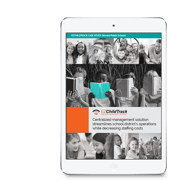
A monthly newsletter, done well, will return your investment in time with increased client retention, engagement, and satisfaction. The very essence of a newsletter is its ability to provide relevant information on a schedule that allows parents and children to look forward to its publication.
You can place any content you like in a newsletter, but the most successful ones are careful to balance between promotional content and information and news of benefit and interest to readers. If your goal is to nurture relationships with your customers, a monthly newsletter is one of the better tools you can use.
Why You Should Send a Newsletter
Newsletters, by their very name, indicate they carry news about your business rather than advertising. A newsletter is a separate container of content parents can rely upon to bring them factual and helpful articles about their children’s experience with your childcare facility.
A newsletter is particularly helpful if you have no way to connect with each of your customers on a personal basis, such as when you have a large facility or multiple facilities. It keeps everyone up to date with the same information.
- Include exciting news such as an award your facility or one of your staff received.
- Share information about new features or classes you have planned.
- Keep your customers updated about an ongoing activity.
A professional newsletter makes your customers feel more in touch with their children and your childcare business because it acknowledges them as the primary caregivers who trust you to care for their children while they work.
The Benefits of a Monthly Newsletter
A newsletter is one of your primary communication channels. A newsletter communicates multiple items in a single publication; readers can choose to read those that are relevant to them without the need to receive separate emails or read through content that is not pertinent to them.
A monthly newsletter is also a potential font of feedback. Each newsletter should contain your business’s email address, so your customers can ask questions and respond to the information provided.
A monthly newsletter extends your reach if you offer it to more people than your current customers. Allow others to subscribe from your website and promote your newsletter through social media channels as a way to showcase the day-to-day operations of your center to prospects or others who may forward your information to friends and family.
Best Practices
There are effective newsletter techniques and not-so-effective methods of creating and distributing your newsletter.
- Set expectations upon subscribing so readers will know what sort of information they can expect to see each month. Some examples are monthly menu offerings, reminders about policies, and the frequency of the newsletter.
- Balance content with promotions. The recommended ratio is 90% information content to 10% promotions. You have room for a focused call to action without overwhelming your reader with advertising.
- Think mobile. Many of your customers will consume your content on a smartphone, tablet, or another mobile device. Make sure your newsletter is formatted properly for each device.
- Keep it exclusive. Your newsletter can provide early access to activities and items to subscribers or provide content they will not find elsewhere.
- Test, track, and refine your newsletter month over month. Set goals and measure the performance of your newsletter against them. If you are hitting the goals, set higher ones if you want. If you are not hitting your goals, determine why not and make changes.
Many email providers have features that help you create an attractive format and automatically formats for different devices (this is called responsive design). They will also offer the capability to monitor a variety of metrics and ensure you comply with regulations about unwanted email and spam.
Metrics to Measure Performance
Tracking performance metrics can help you improve your newsletter delivery and content.
- Bounce Rate - an email “bounces” when it cannot be delivered. This happens when you send to an invalid email address or to a full mailbox.
- Delivery Rate - shows the percentage of email that ends in an email box without being bounced. The delivery metric can also tell you if your newsletter was flagged as spam.
- Spam complaint rates - you can reduce the chance of spam complaints by making subscriptions to your newsletter and opt-in opportunity rather than sending it automatically until the receiver opts-out. Immediately remove recipients from your list when requested.
- Open rate - tells you whether the email was opened (and presumably read) or was left to languish in the pile.
- Unsubscribe rates - indicates excessive emailing, poor email design, or irrelevant content. Respond immediately when asked to remove an email address and try to determine the issue so you can improve.
Without measurements, you don't know if you are wasting your time on a newsletter nobody is reading or whether you are providing the type of information your clients want and need.
A Brief How-To for Creating Effective Newsletters
Encourage your staff and parents to be involved in the creation of the newsletter. Ask for input about features and articles or news from home. Encourage every teacher to share news from their classrooms and ask everyone for feedback on the format.
- Create a simple layout with plenty of white space and a clean format.
- Be consistent with your features and delivery each month.
- Add your branding with color selection, mascots, or other design.
- Keep it brief - two pages maximum.
- Include a calendar of upcoming events.
- Use pictures - parents love to see pictures of their kids having fun.
- Publish the meal or snack menu for the month.
- Place policy reminders on the front page.
- Include highlights from the month about staff and student accomplishments, milestones, and the curriculum.
- Include a referral promotion.
Your newsletter can share important information from families to other parents, creating a sense of community.
A monthly newsletter is a value-added service you can provide for your current and prospective clients. Develop the content with an eye towards your primary audience and encourage engagement from your staff and the parents. Track your performance metrics to learn what does work and what does not.
EZChildtrack can help you deliver your newsletters through the parent portal included in our web-based childcare software. Publish your newsletter as a bulletin and allow parents to read or download it at their convenience without sending it to their email inbox.
For delivery to prospects and others interested in your services, use an email service such as Constant Contact or MailChimp that provide tools for you to track metrics and save email lists for marketing purposes.




